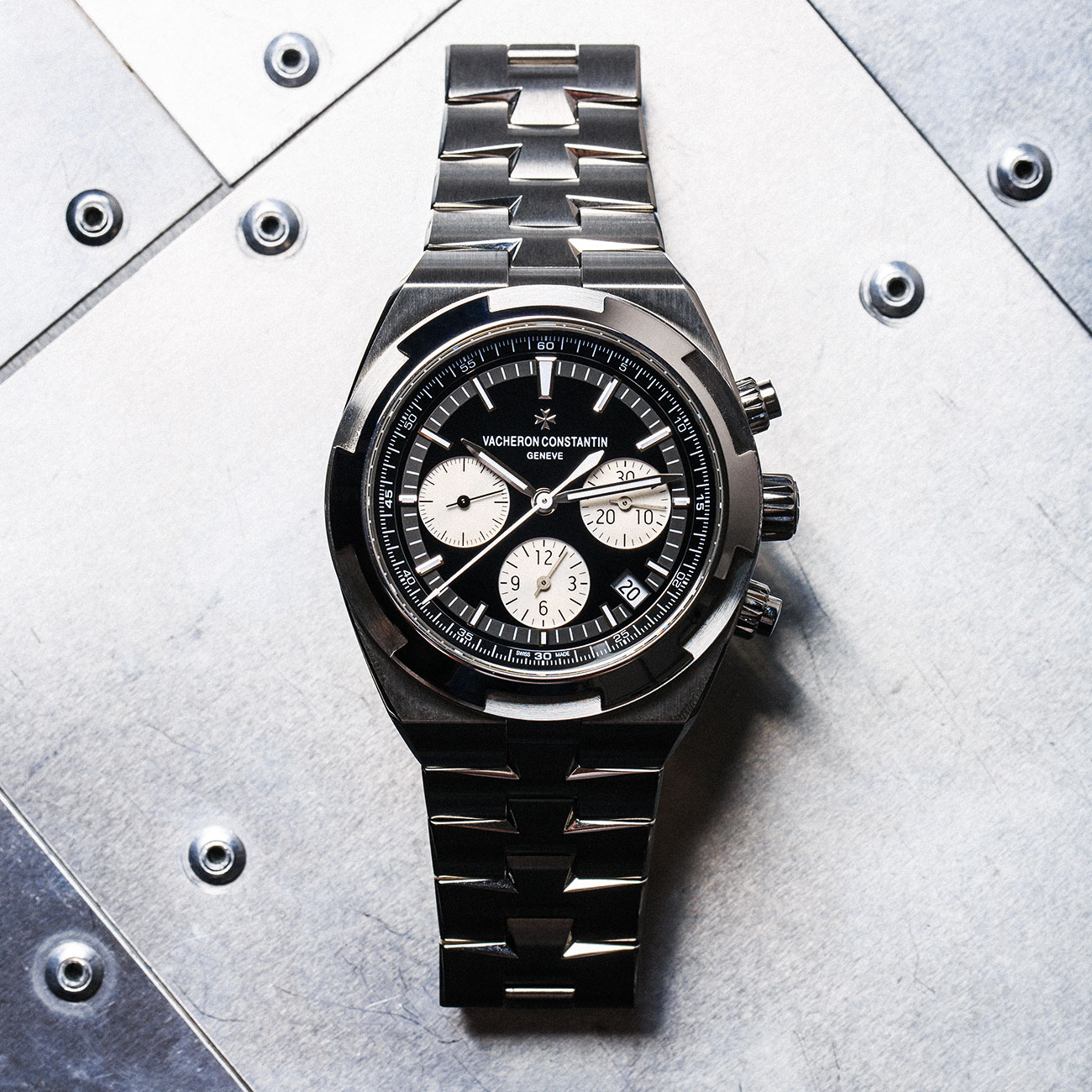Released in April, the new Vacheron Constantin Overseas Chronograph is the latest addition to the brand’s Overseas range of luxury sports watches, meant to do battle with other high-end sports watches from vaunted Swiss manufacturers like the Audemars Piguet Royal Oak and Patek Philippe Nautilus. While the Chronograph has existed in the Overseas lineup for some time now, this new model brings a black-and-white “reverse panda” color scheme to the dial. There’s no point in tip-toeing around the elephant in the room, though: at $30,200, it’s a ludicrously expensive watch.
Any reasonable person would say that’s too expensive. But the Overseas is far from the only timepiece in this price bracket — there are plenty of watches sporting precious metals, absurd complications and irrefutably brash designs, making clear to observers that they are, in fact, worth their five-figure price tags. But the Overseas doesn’t have any of these things. Its made out of stainless steel. It has a chronograph — a complication for sure, but it’s nothing unordinary. Its design isn’t plain, but it is decidedly understated.
From a distance, some watches — Pateks, Rolexes, Audemars Piguets — are identifiable by their iconic and bold silhouettes, but there’s not much to distinguish the Vacheron for what it is, despite the fact that the Overseas design has been around since the 1970s. The difference between, say, a Royal Oak and the Overseas is a lot like the difference between a Bentley Continental and a Volkswagen Phaeton: one you know is expensive at first glance, the other requires closer inspection to understand its value. Stealth wealth, some call it.
The Good: When you do take a closer look, it does become immediately apparent how special this watch is and how thought-out almost every detail is. It’s an incredibly well-executed design with an impressive amount of finishing both inside and out. The movement, in particular, is a gem — it was designed in-house by the brand and carries the Geneva Seal, which means that it meets a lofty set of requirements regarding engineering and finishing. It’s a deeply nerdy piece of high-end watchmaking but it exists in a watch that’s still water-resistant to 150 meters and anti-magnetic. In short, the Overseas Chronograph is a piece of haute horologerie you could comfortably wear on a daily basis. You can’t say that about a lot of other watches in its price range.
Who It’s For: Somebody who loves watches (like, really loves them), has the means to spend $30,000 on a timepiece and is looking for a casual, daily wear, albeit one with all the hallmarks of fine watchmaking. However, I’d go so far to say this could even work as a dressier watch when paired with the included leather strap or bracelet.
Watch Out For: Part of the appeal of luxury sports watches like the Overseas is that despite their utility they’re generally pretty thin and compact. At 42.5mm wide and 13.7mm thick, the Overseas isn’t. Blame it on the nature of automatic chronograph movements if you will — they’re inherently thick to accommodate all the mechanics — but even the Overseas’ competitor from Audemars Piguet — the Royal Oak Chronograph — comes in at 41mm in diameter and under 11mm thick. Were the Overseas ever so slightly thinner and smaller, it would give the watch a sleeker look and would fit much better on the wrist. Its pretty much the only thing keeping it from being perfect.
Alternatives: In the realm of ultra-high-end sports watches, there are really only two direct competitors for the Overseas Chronograph, and oddly enough the Vacheron falls in the middle regarding price. A more affordable option is the aforementioned Audemars Piguet Royal Oak Chronograph which also was recently given a black-and-white update. That’ll set you back $24,300. The more expensive alternative would be the Patek Philippe Nautilus Chronograph which goes for an eye-watering $53,300. Both are arguably more iconic designs and therefore more immediately recognizable than the Overseas, which can be good or bad depending on what you want in the end; the Vacheron is arguably the more stealthy option.
Review: Walking around with such a pricey watch often feels like having a target on your back. But the Overseas Chronograph never drew side-eyes or menacing glares. I visited Michigan Avenue’s Tourneau store where the man behind the counter didn’t seem to understand what the Overseas was. Conversely, the only person I encountered who did seem to understand the value of the Overseas was a young gentleman I met in a Uniqlo whom I complimented on the awesome Seiko SKX013 he was wearing. “Oh wow,” he said when he saw my wrist. “It’s not actually mine, I’m just borrowing it for a story I’m writing,” I assured him because a) deliberately flashing a $30,000 watch you own feels tacky and b) it’s more confusing than anything when the guy wearing said $30,000 watch is waiting in line for a fitting room to try on an armful of $10 t-shirts and a $30 windbreaker.

He was probably drawn in by the dial. The black-and-white “panda” (or in this case “reverse panda”) dial on the Overseas is one of many to come back to watchmaking in full force. The panda trend is a relatively young one in the watchmaking space, but its roots go back to the mid 20th-century when the high-contrast colorway graced many a racing or aviation chronograph. It’s contrasting sub-dials are eye-catching — much more eye-catching than the monochromatic colorways previously offered on the Overseas Chronograph — but the look is overall dignified.
Look closer than the colorway, and you’ll see more of the fine detailing that Vacheron Constantin is renowned for. The walls of the submerged subdials? Polished to a mirror finish. So are the surrounds of the hour indices. Same for the ends of the chronograph pushers. The spaces between the links are machined and polished in such a way they resemble the brand’s “Maltese Cross” logo. The dial itself is “none more black” levels of deep with just the slightest shimmer. The snailing engraving within the subdials is so faint that, unless you stare for a while, you can barely tell it’s there. There are just a few of the tiny details that most other watchmakers wouldn’t give a second thought.
Inside the watch is Vacheron’s Caliber 5600 automatic movement, an in-house effort that came to fruition in 2016 after five years of development. It’s cam-actuated with a verticle clutch, and as you’d expect that means the pusher action to start, stop and reset are buttery smooth. Flip the watch over, remove the quick-release strap or bracelet and gaze at its beauty. The bridges are beautifully finished with Geneva stripes, the rotor cast in solid rose gold. The column wheel is visible at the twelve o’clock position, and look closely, and you’ll find that in the center a very tiny Maltese Cross has been engraved. That’s such needlessly fine detail you can’t help but love it.
And yet for all its esteemed finishing, this is a watch you can live with day-to-day. You can take the bracelet off and swap it out for leather or rubber within seconds. You can screw down the pushers and go snorkeling with it. Its soft-iron inner ring means can stand near powerful magnetic fields without the decadent movement inside going haywire, which sounds like an absurd statement until you realize magnetic fields are literally everywhere and they can actually throw off your watch’s accuracy. It’s a fine watch, but it isn’t a precious one.
Verdict: The Overseas Chronograph is not a watch that you spend $30,000 on because you want people to know you spent $30,000 on a watch. It’s a true watch nerd’s watch, built for people who appreciate the kind of tireless effort it takes to finish a timepiece to one of the highest standards in the industry. But for all its niceties, this is not the kind of timepiece you keep on a plinth or in a safe. It’s the kind of thing you go out and wear every day with the same intent as you would a $200 Seiko dive watch.
What Others Are Saying:
• “Vacheron’s stock-in-trade when it comes to quality is a slightly less immediately apparent approach; at its best, the company seems to be after a certain kind of understatement, rather than a knock-your-socks-off immediacy. The degree of attention to detail you want from an haute horlogerie product is there, of course (and in spades) but it’s very characteristically Genevan — an expression of sincerity in craft, rather than a desire to draw attention.” — Jack Forster, Hodinkee
• “The biggest competitors to the Overseas are the Royal Oak and the Nautilus. Those models are more popular than the Overseas, but they are also relatively abundant in specific social circles. Does wearing one of them say anything interesting about you, other than that you can afford it? Not really. The Overseas comes with a relatively blank slate. That means the person wearing it gives the watch all the personality that right now Vacheron Constantin isn’t able to.” — Ariel Adams, A Blog to Watch
• “Here, we’re talking about an astonishingly well-finished case and bracelet, an in-house movement, developed with care, with an integrated construction, stamped with the Geneva Seal and overall, a rather elegant approach. So clearly…the new Vacheron Constantin Overseas Chronograph plays in a very limited area: the high-end sports watches, with very few credible competitors. And the good thing is that the new VC Overseas has all the attributes to fight (and win?) against this competition.” — Brice Goulard, Monochrome Watches
Key Specs
Moement: Vacheron Constantin 5200 automatic
Case diameter: 42.5mm
Case thickness: 13.7mm
Water resistance: 150m
Notable features: in-house movement; anti-magnetic; quick-release strap system
Hot takes and in-depth reviews on noteworthy, relevant and interesting products. Read the Story


